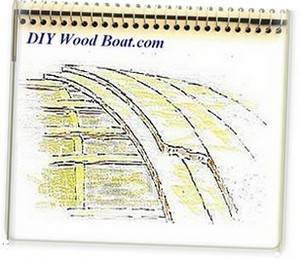- Home
- Your Boats
- Knotty Wood
How To Deal With Knotty Wood.
Knowing
how Knotty Wood affects the strength and stiffness of structural timber
will
allow you to get the best from your boat building lumber.
Softwoods such as those used for the framing of interior fitting are those most commonly affected.
How the knots will affect the stiffness and elastic strength of the timber will depend on their size location and the type of knot.
What’s a Knot?
Knots are the remains of branches which died when the tree was younger and have since been overgrown and buried within the new growth rings.
The trunk’s new growth rings simply surround the dead branch stub often including its bark.
Softwoods such as Conifers are especially prone to knotting all the way up the trunk.
Some such as Scots Pine grow their branches in random clusters.
While in others, such as Spruce the branches and therefore the knots, grow randomly but more evenly spaced.
How loose the knot is, will depend on how long the branch has been dead while the trunk continued to grow.
What is know as a ‘live knot’ will still be attached to the tree whereas a ‘dead knot’ will no longer be attached.
Dead knots are the ones which weaken the timber most and can easily drop out, however both types will affect strength of the piece of timber.
Structural effects of Knotty Wood
In most cases where knotty wood is used as framing for cabin furniture strength is not really an issue.
However, if the timber has to bear any weight, the position of any knots needs to be considered with care.
A settee support of knotty wood might be adequate under normal loads but should a wave rock the boat and someone sit heavily on it, the beam could break suddenly.
How knots will affect the strength will depend on their position, size, number, and condition.
A knot that runs across the top edge of that settee beam will be compressed under load and though it will be a weak spot it will not have a serious effect on strength.
The same knot running along the underside of the beam which, is subjected to tension will in effect be a hole, greatly reducing its load bearing capacity.
The nearer the knot is to the center of the beam the more it will weaken it.
In some instances small knots along the neutral plane of a beam can be an asset as they will help prevent longitudinal shearing.
Knots in boards and planking which go through it at right angles to the broadest surface are unlikely to affect the strength unduly.
The other problem caused by knotty wood becomes apparent when it comes to finishing.
While that darker patch in the wood and the way the grain of the rest of the wood flows around it may look attractive it will make working difficult.
The knotty wood is usually denser than that surrounding it making it harder and more brittle.
Other Timber Defects.
Softwoods are graded for evenness of grain and the number of defects such as knots and Ingrown Bark which will mar the look as well as weaken the board.
Shakes, are splits that occur in the wood due to growth defects or shrinkage stress.
Other defects to watch out for when buying lumber are caused by the drying process.
Wood which is not dried carefully can be stressed in several ways.
Honeycomb checks, occur inside the boards when the outside dries and stabilizes before the interior wood, the inside shrinks more than the outside leading to internal checks.
Surface checking along the rays caused by too quick drying of the surface.
End splits are caused by too quick drying of ends, which could have been prevented by sealing the ends with waterproof paint.
Bowing or warping is usually due to stacking boards badly.
And for restorers the dreaded Wood Rot.
Finishing.
Knotty pine may be fashionable but it will cause problems when it comes to finishing.
That hard brittle lump and the changes or direction of the surrounding grain will make planning smooth a frustrating process.
Normal Smoothing Planes have their blades set at an angle of 45 degrees.
For dealing with difficult grain it is possible to buy planes with a frog which pitches the blade at an angle of 50 degrees or more and some plane makers can supply a high angle frog to convert existing planes.
The other problem with knotty wood is that the resin from the knot will seep through paint leaving a circular brown stain.
To prevent this the knot needs to be painted with a Knotting Solution before priming.
‘Knotting’ is a shellac based sealer.
Another option for small face knots is to drill out the knot and replace it with a glued in plug made from the same material as the surrounding wood.
Flat
sawn wood can be made fairly stable, just by ripping it
down the middle.
The outer edges will be vertical grain, progressively
transitioning to flat in the middle, then back to vertical on the other
edge.
If you run this through a table saw, ripping it right down the middle, you now have two boards, both with a high percentage of quarter sawn material in them.
Now, if you make another pass through the table saw, ripping an inch or so off the heart wood edge, you now have a much more stable board.









